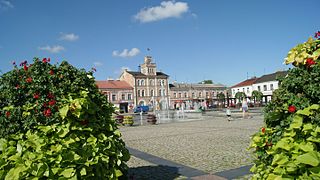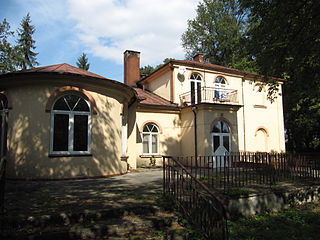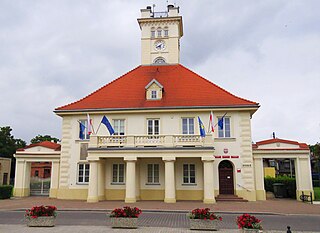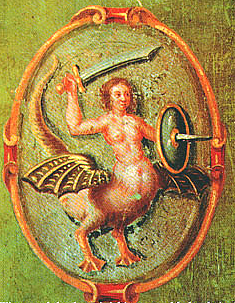
The Warsaw Ghetto was the largest of the Nazi ghettos during World War II and the Holocaust. It was established in November 1940 by the German authorities within the new General Government territory of occupied Poland. At its height, as many as 460,000 Jews were imprisoned there, in an area of 3.4 km2 (1.3 sq mi), with an average of 9.2 persons per room, barely subsisting on meager food rations. From the Warsaw Ghetto, Jews were deported to Nazi concentration camps and mass-killing centers. In the summer of 1942, at least 254,000 ghetto residents were sent to the Treblinka extermination camp during Großaktion Warschau under the guise of "resettlement in the East" over the course of the summer. The ghetto was demolished by the Germans in May 1943 after the Warsaw Ghetto Uprising had temporarily halted the deportations. The total death toll among the prisoners of the ghetto is estimated to be at least 300,000 killed by bullet or gas, combined with 92,000 victims of starvation and related diseases, the Warsaw Ghetto Uprising, and the casualties of the final destruction of the ghetto.

The General Government, formally the General Governorate for the Occupied Polish Region, was a German zone of occupation established after the invasion of Poland by Nazi Germany, Slovakia and the Soviet Union in 1939 at the onset of World War II. The newly occupied Second Polish Republic was split into three zones: the General Government in its centre, Polish areas annexed by Nazi Germany in the west, and Polish areas annexed by the Soviet Union in the east. The territory was expanded substantially in 1941, after the German Invasion of the Soviet Union, to include the new District of Galicia. The area of the Generalgouvernement roughly corresponded with the Austrian part of the Polish–Lithuanian Commonwealth after the Third Partition of Poland in 1795.

Skierniewice is a city in central Poland with 47,031 inhabitants (2021), situated in the Łódź Voivodeship. It is the capital of Skierniewice County. The town is situated almost exactly halfway between Łódź and Warsaw. Through the town runs the small river Łupia, also called Skierniewka.

Łask is a town in central Poland with 16,925 inhabitants (2020). It is the capital of Łask County, and is situated in Łódź Voivodeship. The Polish Air Force's 32nd Air Base is located nearby. It is located in the Sieradz Land.

Siedlce is a city in eastern Poland with 77,354 inhabitants. Situated in the Masovian Voivodeship, previously the city was the capital of a separate Siedlce Voivodeship (1975–1998). The city is situated between two small rivers, the Muchawka and the Helenka, and lies along the European route E30, around 90 kilometres (56 mi) east of Warsaw. It is the fourth largest city of the Voivodeship, and the seat of the Roman Catholic Diocese of Siedlce. Siedlce is a local educational, cultural and business center.

Pruszków is a city in east-central Poland, situated in the Masovian Voivodeship since 1999. It was previously in Warszawa Voivodeship (1975–1998). Pruszków is the capital of Pruszków County, located along the western edge of the Warsaw urban area.

Zgierz is a city in central Poland, located just to the north of Łódź, and part of the metropolitan area centered on that city. As of 2021, it had a population of 54,974. Located within the historic Łęczyca Land, it is the capital of Zgierz County in the Łódź Voivodeship.

The Jewish Combat Organization was a World War II resistance movement in occupied Poland, which was instrumental in organizing and launching the Warsaw Ghetto Uprising. ŻOB took part in a number of other resistance activities as well.

The Warsaw concentration camp was a German concentration camp in occupied Poland during World War II. It was formed on the base of the now-nonexistent Gęsiówka prison, in what is today the Warsaw neighbourhood of Muranów, on the order of Reichsführer-SS Heinrich Himmler. The camp operated from July 1943 to August 1944.

Zaklików is a town in Poland, located in the Subcarpathian Voivodeship, in Stalowa Wola County. It is located 113.1 miles (182 km) SSE of Warsaw and 50 miles (80 km) from Lublin. For about 300 years of its early history Zaklików was incorporated as a city, but it lost its city charter in punishment for the January Uprising against the imperial rule. It was reinstated as a city on 1 January 2014. Zaklików lies approximately 21 kilometres (13 mi) north of Stalowa Wola and 82 km (51 mi) north of the regional capital Rzeszów.

Pławno is a village in the administrative district of Gmina Gidle, within Radomsko County, Łódź Voivodeship, in south-central Poland. The village has a population of 1,200. It lies approximately 4 kilometres (2 mi) north of Gidle, 10 km (6 mi) south of Radomsko, and 90 km (56 mi) south of the regional capital Łódź. It is located in the Sieradz Land.

Beginning with the invasion of Poland during World War II, the Nazi regime set up ghettos across German-occupied Eastern Europe in order to segregate and confine Jews, and sometimes Romani people, into small sections of towns and cities furthering their exploitation. In German documents, and signage at ghetto entrances, the Nazis usually referred to them as Jüdischer Wohnbezirk or Wohngebiet der Juden, both of which translate as the Jewish Quarter. There were several distinct types including open ghettos, closed ghettos, work, transit, and destruction ghettos, as defined by the Holocaust historians. In a number of cases, they were the place of Jewish underground resistance against the German occupation, known collectively as the ghetto uprisings.

Radziejów is a town in Poland, in Kuyavian-Pomeranian Voivodeship, about 45 km south of Toruń. It is the capital of Radziejów County. Its population is 5,696 (2010).

Żychlin is a town in Kutno County, Łódź Voivodeship, Poland, about 50 north of Łódź and 90 kilometres west of Warsaw. It has 7,964 inhabitants (2020).

Błonie is a town in Warsaw West County, Masovian Voivodeship, Poland, with a population of 12,058 as of December 2021.

The destruction of Warsaw was Nazi Germany's razing of the city in late 1944, after the 1944 Warsaw Uprising of the Polish resistance. The uprising infuriated German leaders, who decided to destroy the city in retaliation.

In the early modern era, European Jews were confined to ghettos and placed under strict regulations as well as restrictions in many European cities. The character of ghettos fluctuated over the centuries. In some cases, they comprised a Jewish quarter, the area of a city traditionally inhabited by Jews. In many instances, ghettos were places of terrible poverty and during periods of population growth, ghettos had narrow streets and small, crowded houses. Residents had their own justice system. Around the ghetto stood walls that, during pogroms, were closed from inside to protect the community, but from the outside during Christmas, Pesach, and Easter Week to prevent the Jews from leaving at those times.

The history of Warsaw spans over 1400 years. In that time, the city evolved from a cluster of villages to the capital of a major European power, the Polish–Lithuanian Commonwealth—and, under the patronage of its kings, a center of enlightenment and otherwise unknown tolerance. Fortified settlements founded in the 9th century form the core of the city, in today's Warsaw Old Town.

Radom Ghetto was a Nazi ghetto set up in March 1941 in the city of Radom during the Nazi occupation of Poland, for the purpose of persecution and exploitation of Polish Jews. It was closed off from the outside officially in April 1941. A year and a half later, the liquidation of the ghetto began in August 1942, and ended in July 1944, with approximately 30,000–32,000 victims deported aboard Holocaust trains to their deaths at the Treblinka extermination camp.
Executions in the ruins of the Warsaw Ghetto (1943–1944) – mass executions of Polish Political prisoners and people of Jewish descent carried out secretly by German occupiers in the ruins of the Warsaw Ghetto.




















